Syringaldehyde
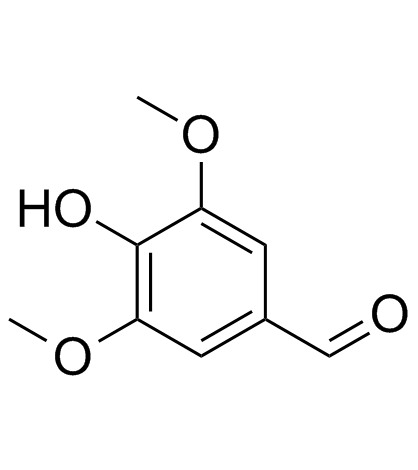
Syringaldehyde structure
|
Common Name | Syringaldehyde | ||
|---|---|---|---|---|
| CAS Number | 134-96-3 | Molecular Weight | 182.173 | |
| Density | 1.2±0.1 g/cm3 | Boiling Point | 322.1±37.0 °C at 760 mmHg | |
| Molecular Formula | C9H10O4 | Melting Point | 110-113 °C(lit.) | |
| MSDS | Chinese USA | Flash Point | 130.1±20.0 °C | |
| Symbol |

GHS07 |
Signal Word | Warning | |
Use of SyringaldehydeSyringaldehyde is a polyphenolic compound belonging to the group of flavonoids and is found in different plant species like Manihot esculenta and Magnolia officinalis[1]. Syringaldehyde moderately inhibits COX-2 activity with an IC50 of 3.5 μg/mL[2]. Anti-hyperglycemic and anti-inflammatory activities[1]. |
| Name | syringaldehyde |
|---|---|
| Synonym | More Synonyms |
| Description | Syringaldehyde is a polyphenolic compound belonging to the group of flavonoids and is found in different plant species like Manihot esculenta and Magnolia officinalis[1]. Syringaldehyde moderately inhibits COX-2 activity with an IC50 of 3.5 μg/mL[2]. Anti-hyperglycemic and anti-inflammatory activities[1]. |
|---|---|
| Related Catalog | |
| Target |
COX-2:19.2 μM (IC50) |
| In Vitro | Syringaldehyde inhibits COX-2 activity in a dosedependent manner with an IC50 of 3.5 μg/mL[2]. |
| In Vivo | Syringaldehyde exerts anti-hyperglycemic effect in rat model of diabetes induced by streptozotocin. Apart from antioxidant capability, Syringaldehyde also has anti-inflammatory activity as it is found to have inhibitory action on cyclo-oxygenase 2 (COX-2) in mouse macrophage cell line[1]. |
| Animal Admin | Rats[1] Adult male albino wistar rats (weighing 180-220 g) 12.5 mg/kg, 25 mg/kg, and 50 mg/kg; p.o.; for 21 days Adult male albino wistar rats are randomly divided into six groups (n=6), first group serves as control and receives vehicle (orally) for 21 days. Second group is given Syringaldehyde in saline orally at 50 mg/kg for 21 days. Third group receives vehicle for a period of 21 days and then ISO (100 mg/kg, s.c.) on 20th and 21 st day at an interval of 24 h. Fourth group is given Syringaldehyde for 21 days at 12.5 mg/kg, p.o. and ISO on 20th and 21 st day. Fifth group receives Syringaldehyde at concentration of 25 mg/kg, p.o. for 21 days and ISO on 20th and 21 st day. The sixth group is treated with 50 mg/kg of Syringaldehyde for 21 days and ISO on 20th and 21 st day. During the experimental procedure body weight of animals are monitored and on 22nd day, 24 h after second injection of ISO, rats sre sacrificed by cervical decapitation. Note: Body weight of animals belonging to different groups did not differed significantly but heart weight of ISO challenged animals were highly elevated (p ≤ 0.05) than control rats. However, treatment of rats with Syringaldehyde significantly reduced heart weight in dose dependent way. The rats treated with Syringaldehyde alone displayed an insignificant difference from control group. |
| References |
| Density | 1.2±0.1 g/cm3 |
|---|---|
| Boiling Point | 322.1±37.0 °C at 760 mmHg |
| Melting Point | 110-113 °C(lit.) |
| Molecular Formula | C9H10O4 |
| Molecular Weight | 182.173 |
| Flash Point | 130.1±20.0 °C |
| Exact Mass | 182.057907 |
| PSA | 55.76000 |
| LogP | 0.86 |
| Vapour Pressure | 0.0±0.7 mmHg at 25°C |
| Index of Refraction | 1.568 |
| InChIKey | KCDXJAYRVLXPFO-UHFFFAOYSA-N |
| SMILES | COc1cc(C=O)cc(OC)c1O |
| Water Solubility | very sparingly soluble |
CHEMICAL IDENTIFICATION
HEALTH HAZARD DATAACUTE TOXICITY DATA
|
| Symbol |

GHS07 |
|---|---|
| Signal Word | Warning |
| Hazard Statements | H302-H315-H319-H335 |
| Precautionary Statements | P261-P305 + P351 + P338 |
| Personal Protective Equipment | dust mask type N95 (US);Eyeshields;Gloves |
| Hazard Codes | Xi:Irritant; |
| Risk Phrases | R36/37/38 |
| Safety Phrases | S26-S37/39 |
| RIDADR | NONH for all modes of transport |
| WGK Germany | 3 |
| RTECS | CU5760000 |
| Packaging Group | I; II; III |
| HS Code | 29124900 |
| Precursor 9 | |
|---|---|
| DownStream 9 | |
| HS Code | 2912499000 |
|---|---|
| Summary | 2912499000. other aldehyde-ethers, aldehyde-phenols and aldehydes with other oxygen function. VAT:17.0%. Tax rebate rate:9.0%. . MFN tariff:5.5%. General tariff:30.0% |
|
Effect of electron donating groups on polyphenol-based antioxidant dendrimers.
Biochimie 111 , 125-34, (2015) Numerous studies have reported the beneficial effects of antioxidants in human diseases. Among their biological effects, a majority of antioxidants scavenge reactive radicals in the body, thereby redu... |
|
|
Steam explosion distinctively enhances biomass enzymatic saccharification of cotton stalks by largely reducing cellulose polymerization degree in G. barbadense and G. hirsutum.
Bioresour. Technol. 181 , 224-30, (2015) In this study, steam explosion pretreatment was performed in cotton stalks, leading to 5-6 folds enhancements on biomass enzymatic saccharification distinctive in Gossypium barbadense and Gossypium hi... |
|
|
Cellular apoptosis and cytotoxicity of phenolic compounds: a quantitative structure-activity relationship study.
J. Med. Chem. 48 , 7234-42, (2005) In this comprehensive study on the caspase-mediated apoptosis-inducing effect of 51 substituted phenols in a murine leukemia cell line (L1210), we determined the concentrations needed to induce caspas... |
| EINECS 205-167-5 |
| Syringic Aldehyde |
| 4-Hydroxy-3,5-dimethoxybenzaldehyde |
| 4-Hydroxy-3,5-dimethoxybenzolcarbaldehyd |
| Syringaldehyde |
| 3,5-Dimethoxy-4-Hydroxybenzaldehyde |
| Benzaldehyde, 4-hydroxy-3,5-dimethoxy- |
| MFCD00006943 |
 CAS#:6638-05-7
CAS#:6638-05-7 CAS#:86-81-7
CAS#:86-81-7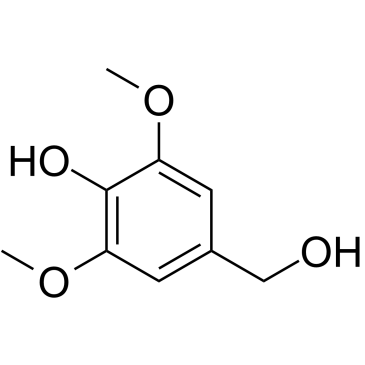 CAS#:530-56-3
CAS#:530-56-3 CAS#:67-56-1
CAS#:67-56-1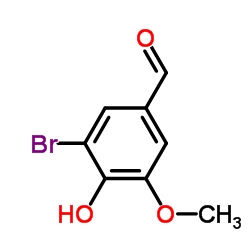 CAS#:2973-76-4
CAS#:2973-76-4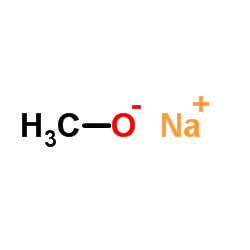 CAS#:124-41-4
CAS#:124-41-4 CAS#:3934-87-0
CAS#:3934-87-0 CAS#:77-78-1
CAS#:77-78-1 CAS#:2973-77-5
CAS#:2973-77-5 CAS#:110233-74-4
CAS#:110233-74-4 CAS#:14779-44-3
CAS#:14779-44-3 CAS#:143363-46-6
CAS#:143363-46-6![3,5-dimethoxy-4-[(4-nitrophenyl)methoxy]benzaldehyde structure](https://image.chemsrc.com/caspic/478/146120-79-8.png) CAS#:146120-79-8
CAS#:146120-79-8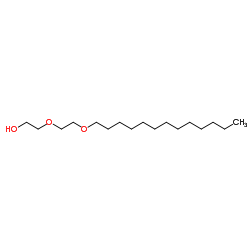 CAS#:14897-78-0
CAS#:14897-78-0 CAS#:14059-92-8
CAS#:14059-92-8![1-[4-(4-formyl-3,5-dimethoxyphenoxy)-2,6-dinitrophenyl]-2,2-diphenylhydrazine structure](https://image.chemsrc.com/caspic/413/1141880-17-2.png) CAS#:1141880-17-2
CAS#:1141880-17-2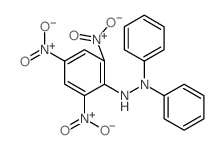 CAS#:1707-75-1
CAS#:1707-75-1
